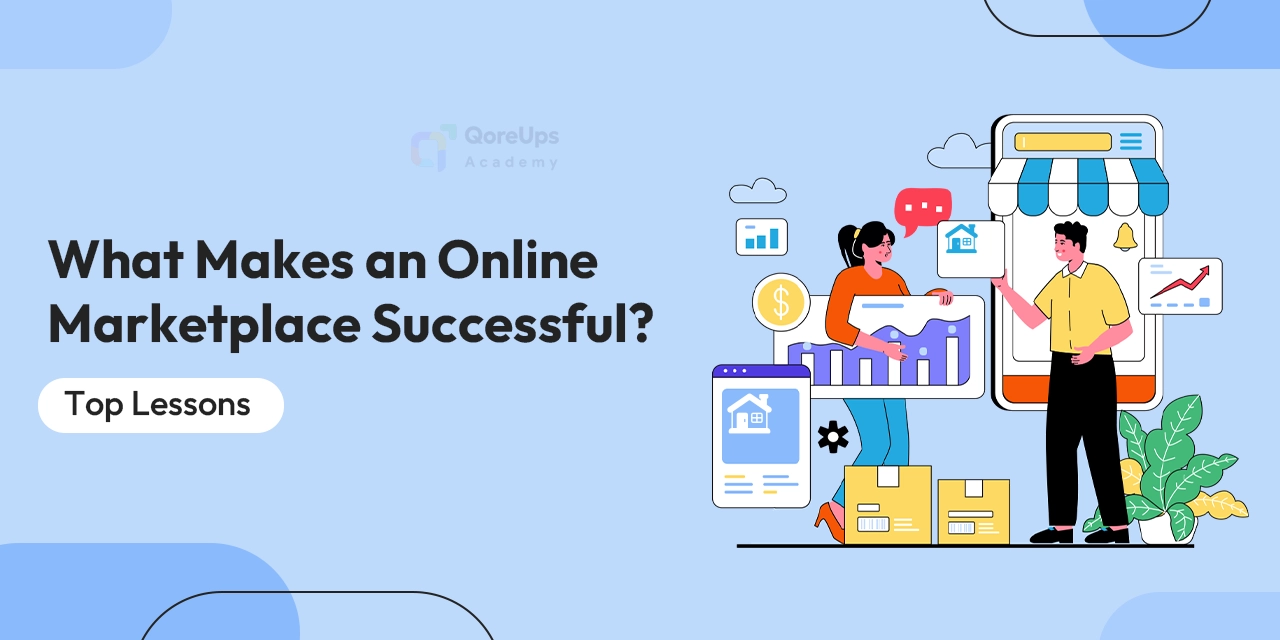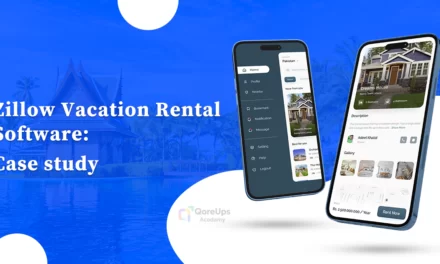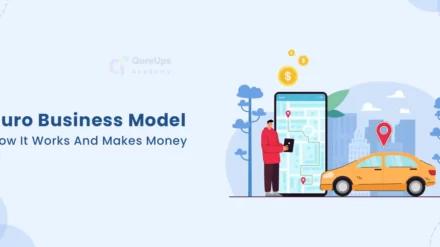“Online marketplaces have changed the way we buy and sell things.”
From big names like Amazon to small specialty platforms, these websites connect users and providers in one easy place.
If you want to build a marketplace—whether a large multi-vendor marketplace or a smaller niche platform—you need to understand what makes these marketplaces work.
Let’s explore what the marketplace model is at first, and then we’ll see the top lessons for building a successful online marketplace, with clear examples and some practical tips.
Understanding the Marketplace Model
An online marketplace is a platform where many providers offer their products or services, and many users come to buy them.
Unlike a regular online store, you don’t keep inventory.
Instead, your job is to create a digital space where both users and providers can connect easily.
For a detailed explanation of how marketplace models function and steps to create one, read our blog: Marketplace Business Model – How It Works & How to Build It.
The hardest part? The Chicken and Egg Problem.
Let me explain it. When you start a marketplace, you need providers to attract users and users to attract providers. Without providers, users won’t find anything to buy. Without users, providers won’t join your platform.
This is called the “chicken and egg” problem.
How to Solve This Chicken and Egg Problem?
- Start by inviting providers first, maybe by offering free listings or other perks.
- Alternatively, you can attract users first by offering special deals, exclusive products, or unique items that are hard to find elsewhere.
- Focus on a niche or local area to build an initial user base before expanding.
To gain a deeper understanding and know more strategies to tackle this problem, we recommend our blog: 10 Tactics To Solve Chicken or Egg Problem Of Online Marketplace.
What are the Different Types of Online Marketplaces?
There are two types of online marketplaces. When you decide to build one, you’ve to choose the type carefully.
- Horizontal marketplaces offer a wide variety of products across many categories. Think of Amazon, where you can buy everything from books and electronics to clothes and groceries. This type aims to attract a broad audience by providing many options in one place.
- Vertical marketplaces, on the other hand, specialize in a specific product category or niche. For example, Etsy focuses mainly on handmade crafts and unique goods. These marketplaces attract users who are looking for something specific or special.
Understanding whether your marketplace will be horizontal or vertical helps you tailor your marketing, user experience, and provider recruitment.
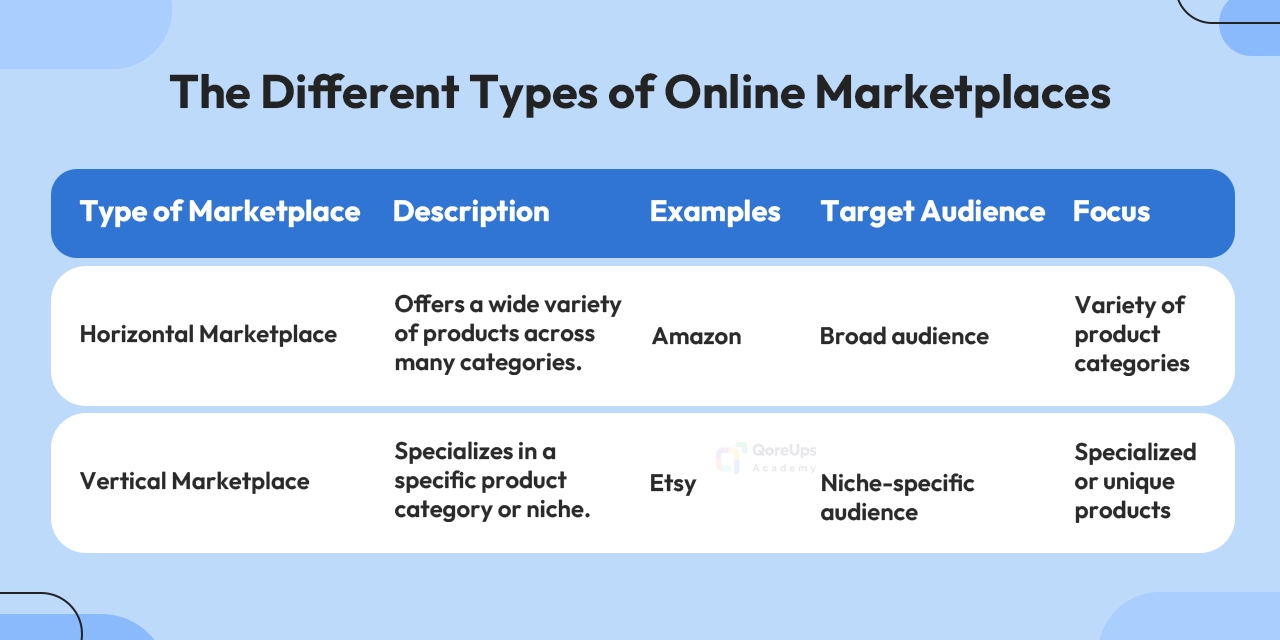
Top 8 Lessons for Building a Successful Online Marketplace
Learn the top 8 lessons that can help you build a marketplace that attracts users, earns trust, and grows over time.
Lesson 1: Build a Strong Community
An online marketplace is more than just a place to buy and sell — it’s a community. The best marketplaces make people feel connected and supported. When users trust providers, and providers feel valued, everyone benefits.
How to Build a Marketplace Community?
- Add communication tools: Let users ask questions and providers respond easily. This builds trust.
- Highlight provider stories: Share provider backgrounds, how they make products, or what drives them. “Etsy does this well — it makes the experience personal.”
- Support your providers: Offer tips, webinars, and tools that help providers succeed. If they grow, your marketplace grows too.
- Encourage reviews: People trust other users. Honest feedback helps future customers make decisions.
When users feel like they belong, they don’t just visit your marketplace — they come back, stay longer, and become part of the community.
Lesson 2: Make the User Experience Simple
If your marketplace is confusing, slow, or hard to navigate, users will leave it — fast. People expect the platform to give a smooth and simple experience. A clean, easy-to-use design helps users feel comfortable and confident. And that’s what makes them come back.
Critical Tips for Better User Experience
- Easy sign-up: Don’t ask for too much information upfront. Let users join in seconds.
- Simple search and filters: Help users quickly find what they need by letting them filter by price, location, or category.
- Mobile-first design: Many people shop on their phones. Your platform must work smoothly on all screen sizes.
- Clear product details: Show prices, delivery times, and return policies clearly to avoid surprises.
- Good visuals: Use high-quality product photos and a clean layout — it builds trust and improves sales.
Example: Amazon’s interface is fast, smart, and incredibly easy to use. Even small marketplaces should aim for this level of clarity.
To see which features can further simplify user navigation and boost engagement, read our blog on the Top 10 Features of an Online Marketplace Platform.
Lesson 3: Match users and providers the Smart Way
The quicker a user finds what they’re looking for, the happier they’ll be and the more likely they are to buy. That’s why smart matching systems aren’t just a bonus; they’re essential. They help connect the right user to the right product, at the right time.
How to Help Users Find the Right Products?
- Start with simple filters: Allow users to filter by price, brand, or location.
- Add smart recommendations: As your marketplace grows, use basic algorithms to suggest similar or popular items.
- Only show available products: Don’t let users waste time on sold-out items. Keep listings updated.
Example: Airbnb shows listings based on location, availability, budget, and more — making it easy for people to book the perfect stay.
Lesson 4: Build Trust and Keep Users Safe
Trust and safety are what keep people coming back to your marketplace.
If users or providers feel something isn’t right, they’ll leave and probably never return. That’s why it’s so important to make everyone feel safe using your platform.
How to Build Trust on Your Platform?
- Verify providers: Ask for ID, business details, or social profiles to keep scammers out.
- Use ratings and reviews: Let users share their experiences. This helps others make smart choices.
- Secure payments: Use trusted systems like PayPal and Stripe to protect both users and providers.
- Write clear policies: Explain returns, disputes, and refunds in plain language.
- Watch for fraud: Use basic tools or manual checks to catch fake listings or bad behavior.
“It takes time for people to trust you, but only a moment to lose that trust.”
Lesson 5: Use Technology That Can Grow With You
When you start your online marketplace, it may be small. But if it works well, it will grow fast. That’s why your technology needs to be ready to handle more users, products, and sales from day one. The right technology saves you from big problems later and helps your marketplace to grow smoothly.
What Your Tech Stack Should Include?
- Cloud hosting: Using services like AWS or Google Cloud means your marketplace can handle more users without getting slow or crashing. It grows automatically as you need more space or power.
- Flexible structure (modular design): Build your marketplace in smaller parts. This way, you can add new features or fix problems without breaking the whole site.
- APIs and integrations: Connect your marketplace with helpful tools like shipping services, email systems, or marketing apps to save time and work better.
- Data security: Protect your users’ information and follow important rules like GDPR to keep everyone safe.
- Monitoring tools: Use software that watches your site to catch and fix problems quickly before users notice.
“Good technology like this means your marketplace runs smoothly, keeps users happy, and grows easily.”
Lesson 6: Have a Clear Monetization Strategy
A marketplace can’t run without making money. It’s how you keep improving your platform, supporting users, and growing your business. You can start simple and add more ways to earn as your marketplace grows.
Effective Ways To Make Money From Your Online Marketplace
1. Commission Fees
Take a small percentage of each sale. For example, if a provider sells for $100 and your commission is 10%, you earn $10. It’s simple and grows as sales increase. Just keep fees fair so providers stay motivated.
2. Listing Fees
Charge providers a fee to list their products or services. This helps keep listings serious and high-quality. Start low or free to attract providers, then add fees later as your marketplace grows.
3. Subscription Plans
Offer monthly premium plans with extra features like better visibility or marketing tools. This works well for frequent or professional providers who want to boost sales.
4. Promotions and Ads
Let providers pay to promote their listings or place ads on your site. This helps them get more sales while providing extra income for you.
5. Add-On Services
Sell extra services like payment protection, shipping help, or priority support. These add value and encourage users to stay loyal.
Pro Tip for Monetization
Start with low or no fees to attract users and build your marketplace’s reputation. Once your platform grows and users see the value you provide, you can gradually increase fees or add premium services. This way, you keep providers happy while creating a steady income from your business.
Curious about which monetization model best fits your business idea? Learn more in our article: How Does Marketplace Make Money.
Lesson 7: Market Your Marketplace to Grow Fast
Even the best online marketplace won’t succeed if people don’t know it exists. Marketing is essential to bring in both users and providers — especially when you’re just starting out.
Smart Ways to Market Your Marketplace
Content Marketing & SEO
Create useful articles, how-to guides, or tutorials that answer questions people search for on Google. This helps your marketplace show up in search results and attract visitors naturally.
Referral Programs
Encourage your users to invite their friends by offering rewards or discounts. Word-of-mouth is powerful and helps your marketplace grow quickly.
Paid Ads
Run ads on platforms like Google, Facebook, or Instagram. These let you target specific groups of people who are likely to be interested in your marketplace, bringing in traffic fast.
Influencer Partnerships
Work with bloggers, creators, or influencers in your marketplace’s niche. Their followers trust them, so a recommendation can bring many new users.
Start with a Niche
Focus your marketing on a small community or a specific product category at first. It’s easier to build a loyal audience before expanding to a wider market.
“Marketing is no longer about the stuff you make, but the stories you tell.” — Seth Godin
Lesson 8: Keep Analyzing and Improving Every Day
Launching your online marketplace is just the beginning. The most successful multi-vendor marketplaces never stop improving. They keep an eye on what’s working well and fix what’s not to grow stronger every day.
Easy Ways to Keep Improving Your Online Marketplace
- Use analytics tools: These tools show you how users behave on your site. For example, where they leave, what pages they visit most, or what products they like. This helps you understand what needs fixing or improving.
- Run A/B tests: Try different versions of your website pages, headlines, or prices with real users. See which version works better, and use the best one to get more sales or sign-ups.
- Listen to your users: Ask users and providers for their opinions and feedback. When you respond and make changes, it shows you care. This builds trust and loyalty.
- Track your marketing campaigns: Find out where your visitors come from and which ads or promotions bring the most users. This helps you spend your marketing budget smarter.
Remember, small improvements every day add up to big success over time. Keeping your marketplace fresh and user-friendly keeps users happy and coming back.
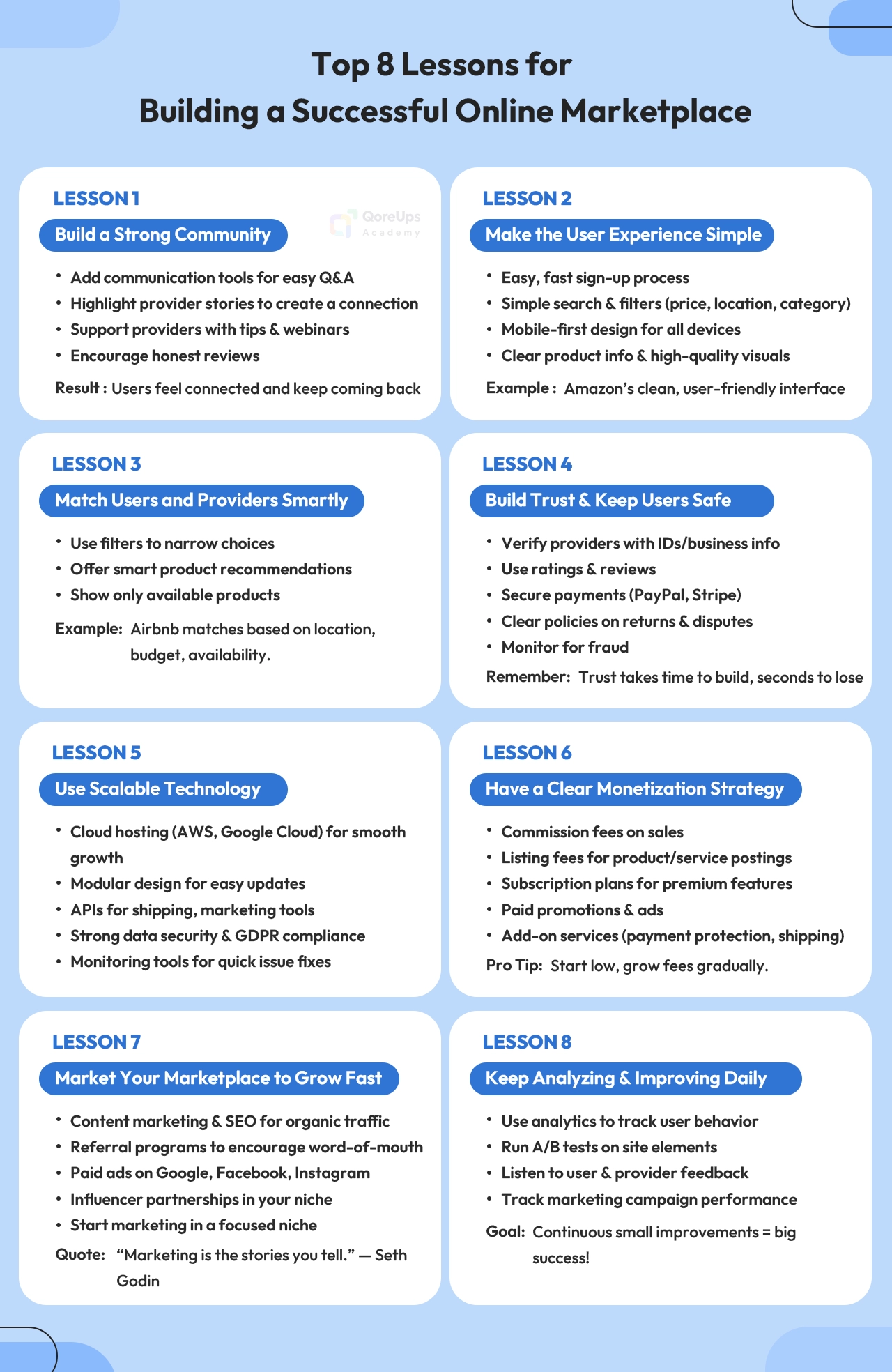
Success Stories: Marketplaces That Achieved Big Wins
Here’s how some of the biggest platforms used these lessons to grow:
Amazon
Amazon is the world’s largest multi-vendor marketplace, known for its vast selection and lightning-fast delivery.
From the start, Amazon focused heavily on building user trust by offering reliable reviews, easy returns, and secure payments. Their smart search and filtering system helps millions of users find exactly what they want quickly.
Amazon’s scalable technology lets it handle huge traffic without slowing down, while its commission-based monetization model grows as providers thrive.
They also generate significant revenue through Fulfillment by Amazon (FBA), where providers pay for storage and shipping services, and advertising tools that providers use to promote their products. The Amazon Prime subscription adds recurring revenue while boosting customer loyalty. They continuously analyze data to improve the user experience, keeping customers loyal year after year.
Etsy
Etsy stands out as a niche marketplace focused on handmade, vintage, and unique goods. Etsy’s success lies in creating a strong community where providers tell their personal stories and users feel connected to the creators.
The platform encourages provider support through workshops and tools, helping small artisans succeed. Etsy’s design is visually appealing, making shopping feel personal and special. They focus their marketing on crafty and creative audiences, making Etsy a go-to destination for unique items.
Etsy earns primarily through listing fees, transaction commissions, and payment processing fees. Additional revenue comes from promoted listings (Etsy Ads) and premium provider tools like Etsy Plus. Etsy shows how focusing on one niche with community and storytelling can build a loyal user base while monetizing gently and effectively.
Airbnb
Airbnb revolutionized travel by creating a platform that connects travelers with local hosts worldwide. They use smart matching algorithms to suggest homes based on location, price, and amenities.
Trust is key here—Airbnb has a strong review and rating system, identity verification, and secure payment options. They also prioritize safety with clear policies and customer support. Airbnb’s growth was supported by aggressive marketing and local partnerships, helping it quickly scale in many countries.
Their commission-based model charges both guests and hosts per booking, aligning revenue with usage.
Airbnb also earns from Airbnb Experiences—local activities offered by hosts—and continues to explore premium offerings. Their technology infrastructure supports millions of listings and users without downtime, helping them scale globally.
Upwork
Upwork connects freelancers with clients across the globe, using a marketplace model that focuses on trust and safety. They verify freelancers’ skills, provide a transparent rating system, and handle secure payments through trusted gateways like PayPal and Stripe.
Upwork’s platform uses matching algorithms to pair clients with the best freelancers based on skills and project needs. They offer subscription plans for premium services and invest heavily in marketing to attract both freelancers and businesses.
Monetization comes from a sliding-scale commission on freelancer earnings, with lower fees for long-term clients. Freelancers also pay for Connects to bid on projects, and both sides can access premium subscriptions for enhanced features and visibility.
Key Takeaway
None of these platforms became giants overnight. They all started small, listened carefully to their users, and kept improving every day. By solving real problems, building trust, and focusing on great user experience, they turned their marketplaces into trusted places where millions of people buy, sell, or rent with confidence.
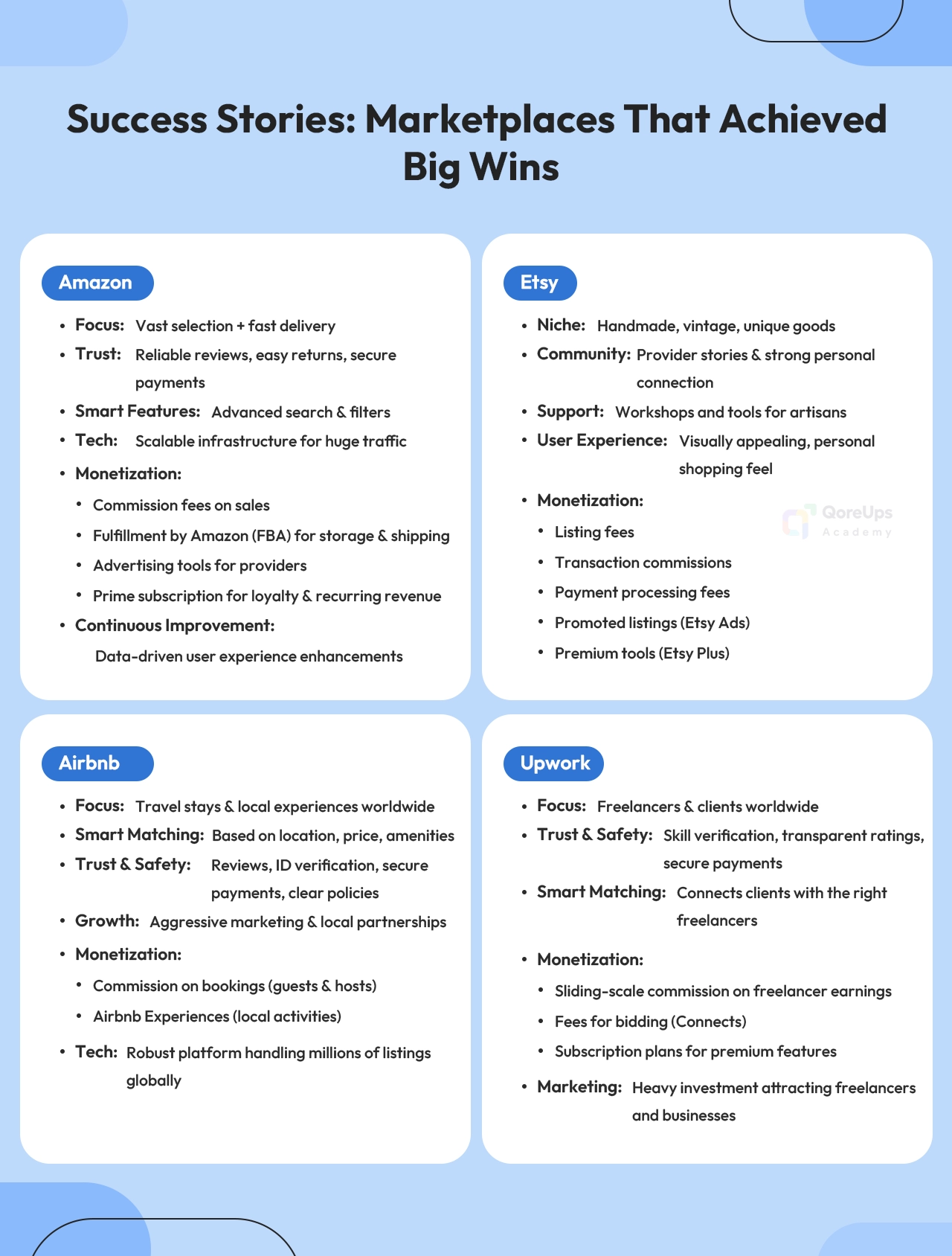
Final Thoughts: What Makes a Marketplace Truly Successful
Creating an online marketplace isn’t just about building a website—it’s about building trust, value, and community.
The most successful platforms, like Amazon, Etsy, Airbnb, and Upwork, didn’t get big overnight. They started small, solved real problems, and kept improving.
Key lessons that you have to remember while building your marketplace:
Start small, grow smart
Begin with a niche you understand well. Focus on one category or one group of users. Once you get traction, you can grow step by step.
Solve the “chicken and egg” problem early
Attract providers by offering free tools or perks. Attract users by offering exclusive or hard-to-find items. Start local or in a niche to build your first community.
Build trust and safety
People won’t use your marketplace unless they feel safe. Use verified profiles, reviews, secure payments, and clear policies to earn trust.
Keep it easy to use
A simple, clean design makes people stay. Fast loading, easy search, and mobile-friendly design are a must.
Make money the smart way
Use fair commission fees, offer premium tools, and let providers pay to promote their listings. Start small with monetization and grow as your users grow.
Tell people about it
No one will find your marketplace if you don’t market it. Use SEO, content, ads, and influencers to spread the word.
Improve every day
Use data and feedback to fix what’s not working and improve what is. Even small changes can make a big difference over time.
The Bottom Line
A “great marketplace” connects people, solves real problems, and earns their trust.
Start with the user. Build with care. Grow with purpose.
If you do that, your marketplace won’t just grow—it will thrive.
FAQs – Building a Successful Online Marketplace
1. What is an online marketplace?
An online marketplace is a digital platform where multiple providers offer goods or services, and users can browse and purchase them. Examples include Amazon, Etsy, Airbnb, and Upwork.
2. What’s the difference between a horizontal and vertical marketplace?
- Horizontal marketplaces sell a wide variety of products across categories (e.g., Amazon).
- Vertical marketplaces focus on one niche or category (e.g., Etsy for handmade goods).
3. What is the “chicken and egg” problem in marketplaces?
The chicken and egg problem in marketplaces refers to the challenge of attracting both users and providers early on. You need providers to attract users, and users to attract providers. Solving this is crucial in the early stages.
4. How do online marketplaces make money?
Common online marketplace monetization methods include:
- Commission fees on sales
- Listing fees
- Subscription fees
- Advertising and promoted listings
- Add-on services like shipping or insurance
5. How do I attract providers and users to my new marketplace?
- For providers: Offer free listings, low fees, and promotional support.
- For users: Provide exclusive deals, hard-to-find items, or a seamless shopping experience.
6. What are some key features every online marketplace should have?
- User-friendly interface
- Secure payment processing
- Ratings and reviews
- Smart search and filters
- Mobile-friendly design
- Communication tools
7. Why is trust important in a marketplace?
Without trust, users won’t buy or sell. Trust comes from verified users, transparent reviews, secure payments, and clear policies.

